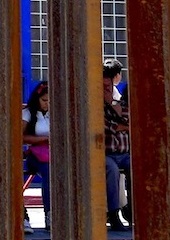The Economic Causes of Migration
After Lampedusa: Should the world be composed of gated communities?
October 22, 2013

What is the message one may take from the latest tragedy in the Mediterranean, where more than 300 Africans died trying to cross to Europe? One way to look at it is simply as a tragedy, one of the many that occur daily in the world.
Another way is to look at it in the context of European migration policies, which have become more restrictive of late. Either of these two ways is, I think, correct but limited.
A better way to look at the issues of migration is in the context of globalization. Three things have changed since approximately the 1980s, and they are what is driving the most recent migration wave.
The disintegration of the world, wage-wise
The first is that countries’ per capita GDPs have diverged: rich countries have, until about 2007, experienced higher growth rates than poor countries. This fact was not much noticed because it was eclipsed by the extraordinarily fast rise of China, and more recently India.
The talk of the global middle class made us forget that ten African countries, with a combined population of 150 million and counting, currently have per capita GDPs lower than at the time of independence. We are also unaware that in the 20 years between 1980 and 2000, Africa’s average per capita growth rate was zero. Thus, today the gap between rich countries like the United States and poor countries like Madagascar is 50 to 1. That is up from a ratio of 10 to 1 in 1960.
Large gaps in mean incomes and wages are obviously a magnet for migration. As a recent UBS “Prices and Earnings” report shows, for exactly the same job of bus driver, the real hourly wage rate (adjusted for the cost of living) is $20 in Amsterdam and only $3 in Mumbai.
Using the U.S. New Immigrant Survey, which records current and past wages of recent U.S. green card holders, Mark Rosenzweig documents not only the gaps between U.S. and migrant countries’ wages but also between migrant countries’ themselves. A South Korean high school graduate earns ten times as much as an Indian, while a Mexican college graduate earns three times as much as one in Indonesia.
It does not require huge sophistication to realize that one can multiply one’s standard of living severalfold by migrating to a richer country. Moreover, even an informal job, not covered by official wage rates, will yield to many people from poor countries much higher income than they can expect at home.
People in today’s crisis-stricken Europe forget how much richer Western Europe is compared to most of Asia, and practically all of Africa. To give just one example: The poorest 1% of the Danish population has an income higher than 95% of the people living in Mali, Madagascar or Tanzania.
Everybody knows about income gaps
But large income gaps cannot produce migration flows unless other conditions are present. The second thing that has changed since the 1980s is much greater awareness of these income gaps.
This is, as recently documented by Andrew Clark and Claudia Senik, not only the product of globalization itself (TV, internet and social media). It is also the result of greater political openness of countries like the former Soviet bloc, China and Burma.
People today know much better the difference in living conditions they and their children can expect in the rich world compared to their home.
Who can afford to migrate?
Finally, the third thing that has changed is the cost of transportation. It is still not negligible.
It is not the poorest of the poor who migrate but the slightly better off, who can afford to do so. For them, the costs of migration, however hazardous the conditions may be, have gone down.
These three changes explain most of the migration pressure. But the question is: What can be done to either stem or manage it?
One possibility is the policy that the rich countries have followed so far, as illustrated by the building of the Mexican “fence” along the U.S. border — or EU’s “interdiction” of access to its shores. That is the equivalent of creating gated communities at the global level.
The European and U.S. examples are the best known, but not isolated. Saudi Arabia has built a fence against Yemen, India is building one against Bangladesh, Spain’s exclaves of Ceuta and Melilla, ports on the Moroccan coast, are entirely fenced in against would-be African migrants.
This is a defensive approach and, however tough and costly, it is capable only of moderately stemming the tide of migration, and produces sporadic tragedies like the one at Lampedusa. It also raises many uncomfortable ethical questions about the right to stop the free movement of labor, while capital, goods, technology and ideas are supposed to move freely.
A better alternative would be a concerted policy by rich countries to allow much greater and orderly immigration of both skilled and unskilled labor through temporary workers programs. This would involve regularizing the ability of foreigners from poor countries to apply for and get jobs in rich countries, and generally to implement more lenient and targeted migration policies.
Our view of development itself has to change, away from the “methodological nationalism” that is not suitable for the era of globalization. From a global point of view, whether a person’s income increases while he is in his own country or elsewhere is unimportant because global development is about higher incomes of individuals, regardless of where they live.
Of course, from the political point of view of a nation-state, these two options are far from being identical. But we have to begin perhaps adjusting our political institutions — and certainly our way of thinking — to be more in sync with globalization. If factors of production are free to move, then this must apply to labor as well.
Takeaways
Issues of migration can only be properly understood in the context of globalization.
Large gaps in mean incomes and wages are obviously a magnet for migration.
People in today’s crisis-stricken Europe forget how much richer western Europe is compared to most of Asia.
Is it right to stop the free movement of labor, while capital, goods, tech and ideas are supposed to move freely?
Our view of development must shift away from “methodological nationalism” unsuited to an era of globalization.
Global development is about higher incomes of individuals regardless of where they live.
If factors of production are free to move, then this must apply to labor as well.

